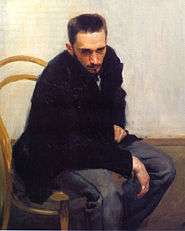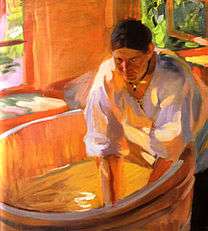Oleksandr Murashko

Oleksandr Oleksandrovych Murashko (Ukrainian: Олександр Олександрович Мурашко); also known as Alexander Murashko and Aleksandr Murashko (August 26 or September 7, 1875 – June 14, 1919) was a Ukrainian painter.
Life and career
Murashko was born in Kyiv. His stepfather, Oleksandr Ivanovych Murashko, had an icon-painting workshop and worked on the interior of St Volodymyr's Cathedral.[1][2]
In 1894, with recommendations from several prominent artists, he entered the Imperial Academy of Arts in St Petersburg. In 1896 he became a student of Ilya Repin;[1] he is one of those depicted in Yelena Makovskaya-Luksch's group portrait, Repin's Students.[3] In 1901 he travelled abroad, visiting Germany, where he studied with Anton Ažbe in Munich,[3] Italy, and France, where he was greatly influenced.[1]
Murashko became a successful artist; he has been called "the most important Ukrainian artist of the turn of the century".[4] His painting Carousel won the gold medal at the Munich Exposition in 1909, and he exhibited in Venice, Rome, Amsterdam, Berlin, Cologne, and Düsseldorf.[1]
From 1909 to 1912 Murashko taught at the Kyiv Art School. In 1913 he opened his own studio,[1][5] where many young Jewish artists were trained, including Mark Epstein.[6][7] He had a great influence on Kazimir Malevich.[8]

He was a patriotic Ukrainian, one of the adherents of the "Young Muse" movement which was started in 1906 by Modernists who drew on developments elsewhere in Europe to make Ukrainian art more progressive.[9] He founded the Association of Kyiv Artists in 1916[10] and the following year co-founded the Ukrainian State Academy of Arts.[1]
In 1909 Murashko married Marguerite Kruger, a notary's daughter.[1] In 1910, after his father's death, he bought a small house in the Kiev suburb of Lukyanivka. He was taken away from the house, apparently by a street gang, and shot from behind on June 14, 1919. His funeral was well attended and he was buried in Lukyanovsky Cemetery.[1]
Works
Originally a realist in the style of the Peredvizhniki,[8] Murashko later painted in a "refined", Impressionist style influenced by his time in Munich and Paris.[11][12][13] His Modernism in turn influenced later Ukrainian artists in the Socialist Realist period.[14] His works are less often narrative and unusually expressive for Ukrainian paintings of the time.[4]
Selected list of paintings

- Portrait of Nikolai Petrov, 1897–98
- Portrait of Helen Murashko, 1898–99
- Portrait of Olga Nesterov, 1900
- The Funeral of the Chieftain, 1900[15]
- Parisian. At the Cafe, 1902–03
- Girl in a Red Hat, 1902–03
- A Girl with a Dog. Portrait of T. Yazevoyi, 1903–04
- Portrait of Professor Adrian Prahova, 1904
- Winter, 1905
- At the Embroidery Frame. Portrait of Helena Prahova, 1905
- Carousel, 1906
- In the Stern. Portrait of George Murashko, 1906
- Sunspots. Portrait of George Murashko, 1908
- Portrait of Marguerite Murashko, 1909
- The Annunciation, 1909
- Portrait of Ludmilla Kuksin, 1910
- Portrait of Vera Dytyatinoyi, 1910
- Portrait of Vera Yepanchin, 1910
- By the Pond. Portrait of Marguerite Murashko, 1913
- Peasant Family, 1914
- Washerwoman, 1914
- Portrait of an Old Woman, 1916
- Woman with Flowers, 1918
- Self Portrait, 1918
- Paintings by Oleksandr Murashko
 Portrait of Mykol Petrov
Portrait of Mykol Petrov Portrait of Ludmilla Kuksin (1910)
Portrait of Ludmilla Kuksin (1910) Winter (1905)
Winter (1905) Washerwoman (1914)
Washerwoman (1914) By the Pond. Portrait of Marguerite Murashko (1913)
By the Pond. Portrait of Marguerite Murashko (1913)
References
- 1 2 3 4 5 6 7 8 "Митець свiтового рiвня Олександр Мурашко (1875–1919)" Українська культура 1 (1999) 25–26, archived at the Wayback Machine, March 5, 2007 (Ukrainian)
- ↑ Oksana Onoprii︠e︡nko, "Oleksandr Murashko (1875–1919), Painter, educator, public figure", in Vydatni dii︠a︡chi Ukraïny mynulykh stolitʹ: memorialʹnyĭ alʹmanakh / Outstanding Ukrainian Personalities of the Past: Memorial Anthology, Zoloti imena Ukraïny, Kiev: I︠E︡vroimidz︠h︡, [2001], ISBN 9789667867058, p. 379.
- 1 2 Anna Novakov, Play of Lines: Anton Ažbe's Art Academy and the Education of East European Female Painters, San Francisco: Fibonacci Academic Press (Lulu.com), 2011, ISBN 9781257373321, p. 50.
- 1 2 Semion Gurok and Boris Lobanovsky, tr. Anne Staros, Kiev, Architectural Landmarks and Art Museums: An Illustrated Guide, Leningrad: Aurora, 1987, OCLC 17202963, p. 75.
- ↑ Igor Aronov, Jewish Art 21/22: Eastern Europe 1 (1995/1996) p. 130.
- ↑ Jews in Eastern Europe 1993, p. 13.
- ↑ Myroslav Shkandrij, "National modernism in post-revolutionary society: the Ukrainian renaissance and Jewish revival, 1917–1930", in Shatterzone of Empires: Coexistence and Violence in the German, Habsburg, Russian, and Ottoman Borderlands, ed. Omer Bartov and Eric D. Weitz, Bloomington: Indiana University, 2013, ISBN pp. 445–46.
- 1 2 Gerry Souter, Malevich: Journey to Infinity, Temporis Collection, New York: Parkstone, 2008, ISBN 9781780429267, p. 47.
- ↑ Andrew Wilson, The Ukrainians: Unexpected Nation, New Haven: Yale University, 2000, repr. 2002, ISBN 9780300093094, p. 135.
- ↑ Bert Cardullo, Theories of the Avant-Garde Theatre: A Casebook from Kleist to Camus, Lanham, Maryland: Scarecrow, 2013, ISBN 9780810887046, p. xxxviii.
- ↑ Shevchenko Scientific Society, Ukraine: A Concise Encyclopaedia, ed. Volodymyr Kubijovyc, Volume 2, Toronto: Ukrainian National Association, University of Toronto Press, 1971, ISBN 9781442673199, p. 564.
- ↑ Ivan Katchanovski, Zenon E. Kohut, Bohdan Y. Nebesio and Myroslav Yurkevich, Historical Dictionary of Ukraine, Historical Dictionaries of Europe 45, Lanham, Maryland: Scarecrow, 2013, ISBN 9780810853874, pp. 376, 430.
- ↑ Philip L Wagner and Zarko Bilbija, University of Chicago Division of the Social Sciences, Aspects of Contemporary Ukraine, Subcontractor's monograph, HRAF-20, New Haven, Connecticut: Human Relations Area Files, [1955], OCLC 4299203, p. 314.
- ↑ Wilson, p. 144.
- ↑ Serhy Yekelchyk, Stalin's Empire of Memory: Russian-Ukrainian Relations in the Soviet Historical Imagination, Toronto: University of Toronto, 2004, ISBN 9781442680166 , p. 145.
Further reading
- Dmytro Antonovych. Oleksander Murashko: 1875–1919. Maĭstri ukraïnsʹkoho mystet︠s︡tva. Prague: Vyd-vo Ukraïnsʹkoï molodi, 1925. OCLC 30000730 (Ukrainian)
- A. Shpakov. Oleksandr Oleksandrovych Murashko: narys pro zhytti︠a︡ i tvorchistʹ. Kiev: Derz︠h︡. vyd-vo obrazotvorchoho mystet︠s︡tva i muz. lit-ry URSR, 1959. OCLC 220406952 (Ukrainian)
- Олександр Мурашко. Твори з колекції національного художнього музею України. Catalogue. Kiev: National Art Museum of Ukraine, 2000. pdf download (Ukrainian)
External links
-
 Media related to Oleksandr Murashko at Wikimedia Commons
Media related to Oleksandr Murashko at Wikimedia Commons